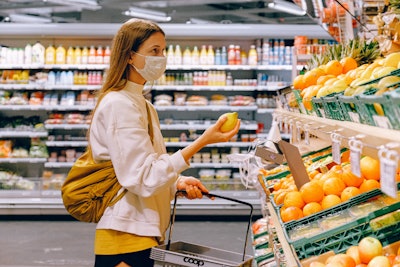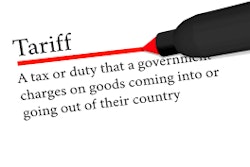
Disrupted supply chains are among the most salient impacts of the COVID-19 pandemic on the food and beverage industry, due to border closures, travel restrictions and trade embargos. This week, Mintec focuses on the logistical impacts of the virus on specific commodity supply chains, given that these factors are expected to remain the key price drivers.
Government intervention is prevalent in many regions to ensure minimal supply disruption for certain key commodities. Meanwhile, the short-term supply of other commodities will remain subdued by the pandemic. In these cases, governmental policy is required to protect the interests of the stakeholders involved, to ensure food security.
Mintec analyses the impact of the pandemic on supply and demand fundamentals, while also considering logistical constraints in getting some key commodities to market.
Americas
Freight restrictions hampering Brazilian agricultural exports
The coronavirus pandemic has impacted agricultural supply chains due to the restrictions placed on social movement. Disrupted trade flows are evident from countries of origin, as well as end-user markets. Brazil, a major supplier of soyabean, sugar, maize and coffee, officially closed its land borders on 18th March to try to contain the virulent spread. The federal government and individual states have implemented varying degrees of restrictions to all forms of transport. The measures threaten to disrupt food production and the movement of farm products to supermarkets and ports.
Brazil relies primarily on road freight to move agri-goods. Indeed, almost two-thirds of domestic cargo is transported by roads compared with only 20% by rail, according to January data from the National Transport Confederation. Brazilian sugar production is centered in the south and south-eastern states, and trucks may travel up to 2,000 km from farm to export terminal. With the newly imposed restrictions, truckers face difficulties finding restaurants, rest stops and repair services. However, the Agriculture Ministry is allowing truck stops, gas stations and highway diners to remain open as essential services, to help cargo haulers move product to the relevant dispatch points.
Notwithstanding, transport bottlenecks continue to hamper commodities exports, although some degree of supply tightness could provide short-term price support. In early April, the ICE London sugar benchmark fell to its lowest level since October 2019, due to weaker demand as the pandemic escalated. The USDA forecasts global sugar production to fall by 6 million tonnes y-o-y in the 2019/20 season due to lower-expected output from South Asia. Global stocks are also predicted to tighten, given the trade restrictions. Thus, the short-term price outlook is heavily dependent on the demand response to the pandemic and whether consumers become increasingly health conscious during lockdowns, or vice-versa.
Grain Markets: Supply chain likely to be impacted by the effects of COVID-19
Global wheat prices are higher than last year, with US CBOT wheat prices up 11.4% y-o-y as at 23rd April due to strong demand for wheat products and supply chain disruptions as a result of the coronavirus pandemic.
The main market concerns supporting prices are the lockdown and protective measures put in place by major grain exporters. Russia and Ukraine have set an export quota for wheat, raising concerns over global supply, meanwhile in Argentina, grain trucks have been disrupted by the quarantine restrictions.
Transport disruptions to the international trade flow are currently reported to be minimal, but panic buying and stockpiling due to the COVID-19 crisis could result in major challenges around exporters’ response rate, despite ample global supply and positive outlook for production.
Brazilian beef market to regain its export strength
The coronavirus outbreak has caused significant disruptions within the global meat supply chain. Labour shortages and disrupted trade flows are the main factors contributing to the turmoil in the meat market, particularly in the top meat producing and exporting markets. Brazil is the top exporter of beef, and thus this section focuses on the impact of COVID-19 on the Brazilian beef market.
The Mintec Brazilian beef price fell by 5% m-o-m in March 2020 due to lower exports to China, driven by trade disruptions caused by the COVID-19 pandemic.
China is one of the top export destinations for fresh and frozen Brazilian beef. Thousands of containers of frozen pork, chicken and beef piled up at some of the Chinese ports in February and early March, as transport disruptions, and labor shortages slowed operations. Also, out-of-home consumption fell in China, thus affecting its import demand. In February, Brazil exported almost 38,000 tonnes of fresh and frozen beef to China, down 4% y-o-y and approximately 30% less than the previous month.
However, in mid-March, China resumed operations at some of its ports. Also, during the same period, China reduced import tariffs on meat, with chicken duties lowered to 4%, beef to 12% and pork to 33%. This is expected to support Brazilian beef and other meat exports to China, strengthening Brazilian beef prices in short-term.
Europe
Fruit and Vegetables Market: Spanish orange prices rise considerably
The COVID-19 pandemic has significantly impacted Europe’s fruit and vegetables market. There has been a rise in demand for specific fruits and vegetables, such as apples and broccoli which are considered to be high in nutrients and have health benefits. In contrast, fruits such as strawberries have seen dramatic declines as consumers gravitate towards less perishable items. Consumer behaviours, alongside migrant shortages, restricted borders and availability of lorry drivers have led to a high level of market uncertainty. This section focuses on the increase in Spanish orange prices.
The Mintec price of Spanish oranges rose by 19% between 2nd March and 17th April 2020, mainly as a result of the coronavirus pandemic. The demand for oranges continues to increase as consumers seek alternative sources of vitamin C and other health nutrients to increase immunity. The growing demand for oranges and the estimated decline in Spain’s 2020 orange production by 25-30% y-o-y have resulted in a bullish sentiment across the Spanish orange market.
In addition to the lower production due to storms, logistical production costs have risen. Activities such as sorting and packing have been delayed due to mobility restrictions and hygiene regulations, such as the two-meter distance rule on the work floor. Furthermore, the cross-border restrictions endorsed by Spain and neighboring countries, in response to the coronavirus outbreak have led to significant labor scarcities in critical growing regions.
In response to this, the Spanish government approved a Royal Legislative Decree to ease hiring restrictions in time for the harvest. The legislation will allow unemployed individuals to continue collecting unemployment and social benefits, in addition to income earned under agricultural contracts.
Despite the impact of COVID-19, the current Spanish orange price remains 8% below the average price recorded in 2019. The surge in demand for Spanish oranges and lower estimated production is expected to keep Spanish orange prices firm for the next few months and closer to the 2019 average.
Asia
Dried fruit market sees minimal impact as exporters continue to operate as normal
The Turkish dried fruit industry continues to operate without disruptions. The Turkish president previously reported that maintaining production and exports was the country’s top priority during the COVID-19 pandemic. However, amid growing numbers of confirmed cases, the government has ordered its citizens to stay at home for three weeks.
Some businesses in the service sector are either closed or people are working from home. However, manufacturing, agriculture, as well as seaports and shipping, continue to operate as normal. Road transport has been experiencing delays in conveying foreign cargoes, as drivers are required to self-isolate for fourteen days upon entering Turkey from countries affected by the coronavirus. This has driven road freight prices higher.
A major Turkish exporter of raisins and sultanas confirmed that its factories are working at full capacity. “All our containers leave ports as scheduled”, he also added. Another Turkish exporter said that all their operations are unaffected by the coronavirus. “We experience no delays to our shipments. There are no congestions in ports”, he reported.
Meanwhile, the Mintec Benchmark Price for Turkish sultanas delivered to the EU has fallen by 2.4% m-o-m, currently at $1.86 per kg. The decline can mainly be attributed to a weaker Turkish lira which has now declined very close to 7 per dollar, losing almost 15% since the beginning of the year.
Looking forward, the grape flowering for the 2020 crop has been good, without major frost incidents.
Concluding remarks
This week’s analysis highlights some of the logistical challenges at play amid the coronavirus pandemic and the impact on food and beverage prices. Indeed, labor shortages, transportation bottlenecks and various other factors are hampering the flow of goods to end markets, thus distorting already volatile prices. Government intervention has been key in helping to smooth the path. For instance, the Brazilian government removing restrictions to motorway services and truck stops should help ensure a smoother flow of freight along the road network. Likewise, the introduction of certain labour market legislation in Spain should help ease some of the demands of the workforce.
While strong governance is a requirement during these uncertain times, the ideal solution in dealing with the overall effect of the pandemic remains to be seen. Ultimately, the socio-economic impact of COVID-19 on commodity markets and the consequential policy response will be key.



















